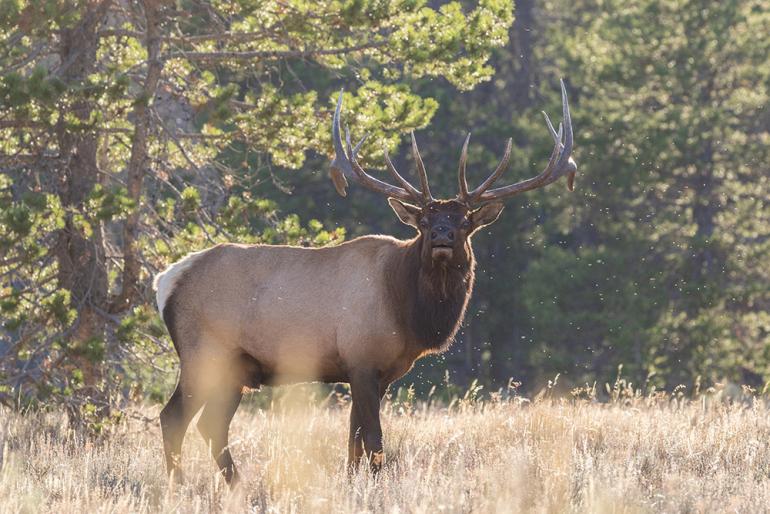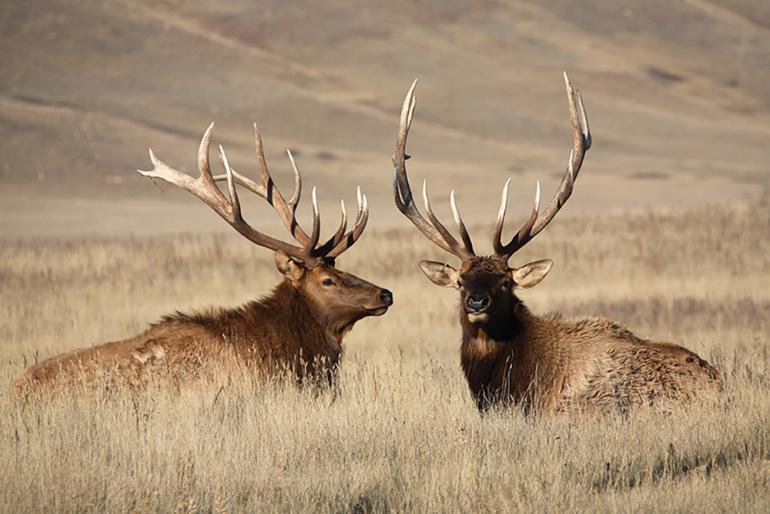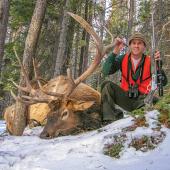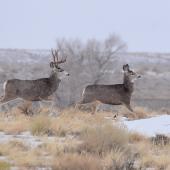Beast of Burden
Bagging a Wapiti.
Sun breaks the skyline and illuminates the fire-scarred basin. Songbirds croon to the morning light, flickering to and fro on nearby aspen branches. Deep below, the meadow is crawling with elk. We hear them before there’s enough light to even see clearly into the draw. Chuckles and barks reverberate hollow-like into the chilled air. They’re followed by the whistling crescendo of a full-fledged bugle.
We spy a cow feeding in the timber opposite us and slump next to a downed log, using a couple small saplings for cover. Next, a shrilling roar to our right. The bull has given away his location.
We clamber downhill over deadfall and through new-growth pines, trying our best to move quietly and keep the wind in our favor. Dried branches crack and early-fall foliage rustles under our boots. It’s far from optimal sneaking conditions, but soon we’re in the creek bottom at the edge of a clearing, the worst of it behind us. We spy a cow feeding in the timber opposite us and slump next to a downed log, using a couple small saplings for cover. Next, a shrilling roar to our right. The bull has given away his location.
Marcus, my cousin and our tag-holder, knocks an arrow and chirps a couple soft cow calls. Bellowing back immediately, the antlered beast presents himself and strides toward us into the open. I hold my breath as I watch his throaty exhalations condense into a cloud of vapor.
Marcus draws and his aim is true. It’s over as quick as it began.
So much of elk hunting is mundane. Long drives, lifeless scouts, sweaty hikes that lead to nothing but sore legs. The ratio of humdrum to excitement is often skewed heavily toward the uneventful. But when the time comes, and your hard work earns you an intimate experience with a riled-up bull elk, it’s enough to make you forget all the monotony it took to get there. Even if an encounter only lasts a few minutes––and rarely are they any longer––these moments are what stick as memory. And they keep us going back year after year.
Marcus draws and his aim is true. It’s over as quick as it began. We approach the fallen bull as adrenaline ages to gratitude. Morning turns to day. We butcher and bag the meat, remove the antlers, and shoulder the load. We’ll remember this for years to come, the first tribute occurring later that night when we share fresh tenderloin roasted on a stick over an open flame.
Habitat
Elk are primarily grazers, and while they’re hardy animals that can survive and endure harsh conditions, they go where food is most readily available. In the warmer months, this tends to be up high where temps are cooler and grasses flourish—anything from sage hills to forested ridges to steep mountainsides. But when the snow falls deep, and it becomes too much work to dig through, they’ll move to lower elevations, spending winters in river valleys or ag fields. Elk are big critters that need big protection. They gravitate toward sizable timber patches that provide abundant security, especially in hunting season when pressure increases.
Behavior
Though they occupy the same habitat, cows and mature bulls generally don’t spend much time together. The exception being the rut, which happens sometime in September. During the rest of the year, large groups of cows, calves, and young bulls often move as a herd between drainages where food is plentiful and security is nearby. Bigger bulls typically stick to themselves deep in the high country. By the time they’ve grown their third set of antlers, they know that people are after them and they become exceptionally good at staying hidden from view. Be it a yearling calf or a seven-year-old monster, elk of all types can travel great distances in a short amount of time. Weather, availability of food and water, pressure from predators, and time of year all play a role as to where they might go next.
Gear
There’s really no way around it—elk hunting demands a certain amount of technical equipment. After a weapon and knife, next up is a good set of boots, something with sturdy ankle support that can move through snow and keep you stable in strenuous terrain. Speaking of strenuous terrain, plan to pack everything you need to stay warm and dry in mountainous conditions, which in Montana can mean everything from freezing rain to relentless snowstorms.
Invest in quality optics, or at least a good pair of binos. You’ll use them routinely glassing for elk, but also for everything else you decide to hunt. Rangefinders also come in handy when judging distance. The more you know about your shot, the less you leave to chance.
For butchering and packing the animal out, have a couple sharp blades in your kit and game bags to store the meat. I carry a small field sharpener in case I need to put a few licks on my knife, and parachute cord in the event that I need to tie a leg off to a tree for leverage. An elk hindquarter isn’t going to fit in your average daypack. Make sure that whatever you’re shouldering can hold and carry at least 70 pounds. Other staples that I never leave without are classic outdoor supplies: firestarter, headlamp, first-aid kit, bear spray, etc.
Bow vs. Rifle
In my opinion, you can’t go wrong either way. Archery season takes place during the rut, when bulls at their most vulnerable, but rifles give you the obvious distance advantage. Both means require a slate of specified gear. For archery, that’s a release, arrows, broadheads, quiver, and a target to practice on. Not to mention the bow itself. There are heaps of reputable brands available, but my advice is to crank your draw weight up as much as you feel comfortable and practice, practice, practice. Rifle hunters should look for something in the 30-caliber range. The .308, .300 Win-Mag, and .30-06 are all tried and true elk-killers. The same rules apply for modern firearms as they do for bows—nothing can substitute for rounds or arrows downrange. Practice early and practice often.
Pack-Out
If you’re hunting elk, you know they’re not small. Unless you have access to a private ranch where the owner has agreed to drive his UTV up to the kill site, packing one out typically involves multiple trips with heavy loads on your back. As mentioned earlier, have a backpack durable and comfy enough to make this process tolerable. Keep in mind that a bone-in hindquarter of a bull elk (without the hide) will likely weigh somewhere between 60 to 70 pounds. A front shoulder will weigh around 20 pounds less than the hind. Then you have the backstraps, neck meat, tenderloins, heart, and head to pack out, which can weigh more than a hindquarter. Take all this into account when planning your hunt. Have good friends on speed-dial, or plenty of time and gas in the tank.
Rut
The rut is an archery hunter’s dream, with a typical peak in mid-September. Cows enter estrus, bringing bulls out of their hidey-holes and turning males into vocal and active specimens. This roughly month-long period is a spectacle to behold, complete with antler-clashing battles, screaming war cries, harem developments, and unrestrained primal behavior. It is also known to make hunters as wild as the elk that experience it.
Regs
Region 3 (southwest Montana) has some of the healthiest elk populations in the state due in large part to the regulations set by FWP. But rules change every year, so make sure you read them in full before you go out. Hard copies can be found at FWP offices and local outdoor retailers. Get the digital regs, buy your licenses, and find more updates at fwp.mt.gov.
Corey Hockett has been eating elk since he was old enough to chew and chasing them since he was old enough to walk. He consistently can’t wait for hunting season.

